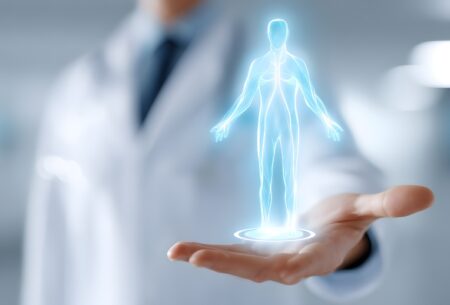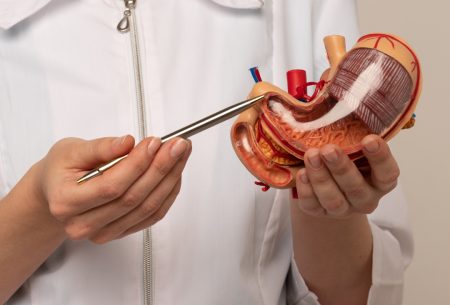Ehlers-Danlos Syndromes (EDS) is the umbrella term for a group of genetic disorders of connective tissue. It affects the structure or function of collagen and other connective tissue proteins that act as a ‘scaffold’ to support structures in the skin, muscles, ligaments and gastrointestinal tract. This affects these structures in a way that makes them more fragile, flexible and ‘stretchy’.
There are thirteen types of EDS. However, the hypermobile type of EDS (hEDS) is the most common type that seems to present with gut symptoms. Some research indicates that chronic gastrointestinal discomfort can be found in around 86% of patients with hEDS which is pretty high!
Other types of EDS can also affect the gut anywhere from the upper digestive tract (oesophagus, stomach and duodenum) to the lower digestive tract (small intestine, large intestine and rectum). Issues with the function of the autonomic nervous system that regulates involuntary physiological processes such as digestion are thought to also be common in EDS and may cause additional gut symptoms.
How does EDS affect the gut?
The digestive tract is made up of a lot of connective tissue that is essential for the waves of the involuntary constriction and relaxation of the muscles of the digestive tract (peristalsis) to ensure good and effective digestion. EDS results in reduced motility of the gut and increased gut sensitivity as the connective tissue is also present around the nerves of the digestive tract.
Some of the symptoms are similar to Irritable Bowel Syndrome (IBS) and EDS is often misdiagnosed as IBS. For example, bloating is a common symptom in people with hEDS and although more research is needed to identify the exact cause, dysmotility is thought to be a contributing factor. Small intestinal bacterial overgrowth (SIBO) is something that can also potentially develop due to reduced motility, sluggish bowels and constipation although as yet there is no definite link between hEDS and SIBO.
Some of the most frequently reported problems affecting the upper digestive tract are acid or bile reflux, indigestion, pain or discomfort, nausea, vomiting and early satiety (feeling full quickly) after meals. Delayed emptying of the stomach contents to a small bowel (delayed gastric emptying) can be the cause of early satiety and nausea and if it is severe can lead to a condition called gastroparesis – a condition that affects the normal spontaneous movement of the muscles (motility) in your stomach, although this is not that common in hEDS and there is no established link between the two.
Evidence suggests that people diagnosed with hEDS may be at a higher risk of having a small hiatus hernia in the oesophagus affecting the oesophagal sphincter (the flap that stops the regurgitation of the stomach contents back into the oesophagus) and thus increasing the chances of suffering from acid reflux and heartburn.
The lower digestive tract problems can result in constipation or diarrhoea and abdominal pain or discomfort. Gut motility is often compromised and sluggish bowels with difficulties in evacuation are reported. It is worth noting that lifestyle and dietary factors can also contribute to constipation, as well as hormones, certain neurological conditions and medications. Therefore it is important to get a full dietary assessment which we perform in our clinic to identify potential reasons for constipation.
How do we manage gut symptoms in EDS?
There is no cure for EDS so management strategies are based on the supportive treatment of symptoms and the prevention of secondary complications.
Based on the dietetic assessment, lifestyle changes along with the therapeutic diet low in fermentable carbohydrates (Low FODMAP) to reduce bloating, gas, discomfort and diarrhoea may be recommended for a certain period of time. This diet is best done under supervision from a registered dietitian as there is a lot to consider in terms of nutritional adequacy and the effect on gut microbiota.
Gut optimisation techniques increasing prebiotic fibre and probiotics may improve gut microbiota composition if there are any imbalances in microbes contributing to the gut issues.
For those with delayed gastric emptying, acid reflux and heartburn, specific dietary recommendations may include the review of the eating habits, reduction of the portions sizes and adjustment of food textures. For those with sluggish bowels and constipation, an increase in fibre, fluids and activity is indicated and if the constipation is not responding to lifestyle and dietary measures, a trial of a medication called prokinetic that stimulates colonic activity may be indicated.
What else is there to consider?
In terms of the prevention of secondary complications involving ligaments and bones, focusing on bone-friendly vitamins and minerals such as Calcium, Vitamin D and K, Magnesium and others is also essential.
As well as dietary and lifestyle changes, therapies such as cognitive behavioural therapy (CBT), specialist pain management, and pelvic floor physiotherapy may also be helpful in the management of all types of EDS.
Final comments
If you have a diagnosis of EDS, suffer from unpleasant gut issues and would like to know more about the gut and EDS connection, make an appointment at the Gut Health Clinic for a full dietary assessment. You can also find information, support and resources from The Ehlers-Danlos Society: https://www.ehlers-danlos.com/












